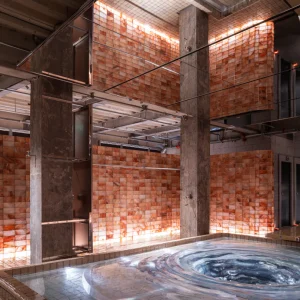
Cidade da Cultura de Galicia is one of the largest projects of Peter Eisenman‘s career. Conceived as an opportunistic attempt to attract cultural tourism and gratuitously to capitalise on the Bilbao effect, Eisenman has created what he calls a “magic mountain”, a 150,000m2 citadel, to express “the culture of Galicia, Spain, Europe, Latin America and the World”. Six new buildings have been cut into the landscape and arranged to reflect the historic memory of the place and its culture. Eisenman has even professed that they tap into ancient laylines. He states that it is a seminal project:”for years to come… people are going to love being here.”
The Cidade da Cultura is located in Santiago di Compostela, a pilgrimage terminus for thousands of Catholics, where miracles are an ever-present reality for believers. Eisenman claims that it stops raining when he goes there. Eisenman is known as a theorist, but this project will refocus attention on to his buildings. It has already attracted criticism in the press for its awkward forms and the potential to distract from the existing Museum of the Galician People designed by Alvaro Siza. He is unlikely to take such attacks seriously, though.

Eisenman says: ‘Labels are always reductive and the demand for simplistic pigeon-holing is typical of a media-driven sensationalism. But it’s a free country and people can call me what they like’.
Given that I had just called him a deconstructivist, a nihilist, an elitist and an anti-humanist, I had a sneaky feeling that he had taken umbrage, but I couldn’t be sure. With postmodernists, it’s all relative.

We had arranged to meet up at the AA where he is a regular visiting lecturer, having taught at Cambridge, Princeton, Illinois and Harvard over the years. He is currently the Louis I Kahn visiting professor of architecture at Yale and claims that he has been simultaneously practicing and teaching longer than anyone else in the world. For 50 years without a break, he’s been educating, practising… and annoying people in equal measure. Famous for quotes like ‘most architects can’t do architecture’ and ‘Buckminster Fuller took great stuff and turned it into shit’, Eisenman is a hoot.
He was born in the year of – and a stone’s throw away from – Philip Johnson’s International Style exhibition at MoMA. That year, 1932, also saw the closure of the Bauhaus in Dessau, and the creation of Lasdun and Lubetkin’s Tecton in London. A born rebel, Eisenman grew up to become a postmodernist. He still carries that torch while eschewing the label. Seventy-eight years later, his latest book is subtitled ‘The Crisis of Modernity’, for example.
Nowadays, he comes across as a man from another age; someone who bestrides the cultural and political chasm between the Sixties and today. He is yer actual public intellectual who appears to have been educated – if not in the rioting banlieues – then at least in the bourgeois coffeehouses of French post-structuralism. He’s hob-nobbed with philosophers, writers and artists and is an intellectual link to a bygone era. His friendship with Jacques Derrida – who posited that ‘truth’ is merely interpretation – framed his present day thoughts on the relative value of knowledge and meaning.
‘I can’t define architecture… I don’t really know what it is but I know that it’s not design. I live in a dumb apartment. I like dumb spaces, dumb buildings… anything that’s not designed. Design has been used to stimulate consumption,’ he says. ‘Architecture, on the other hand, is not necessary. Think about it, nobody needs architecture’.
One of Eisenman’s architectural drivers concerns the concept of Sehnsucht, the unrealisable desire, or inconsolable longing contained in the ‘haunting’ memory of narrative structures. This is well expressed in possibly Eisenman’s best known work: the Memorial to the Murdered Jews of Europe. Situated near the city centre in Berlin, its 2,700 columns have become a tourist hang-out instead of a hallowed monument. For some people, that’s disrespectful and when Easyjet held a fashion shoot there in 2009, Denis MacShane, former Europe Minister described it as ‘the banalisation of anti-Semitism.’ But for Eisenman, the Memorial is banal in many respects: ‘There is no goal; no end; no working one’s way in or out. The duration of an individual’s experience of it grants no further understanding, since understanding is impossible.’

For Eisenman, ‘architecture is about questioning the metaphysical project’, that is: denying the possibility of knowing. In social terms this is indeed nihilistic, but in architectural terms it is merely his attempt to capture an implied vision of a building, rather than its physical reality. Thus he takes issue with Alberti’s proposition that structure should not only be done but that it should be seen to be done, and asks instead whether architecture has to ‘mean or ‘represent’ anything other than itself.
His 1972 project, House VI; which first put his theories into practice resulted in an uncompromising design that had nothing to do with the client, who Eisenman dismissed as an unwelcome ‘intruder’. Stories of his cavalier approach to users are legion, but, as he asks in his defence, how can he be a monster if clients ring him up? How can he be an anti-humanist if he’s designing a 20,000sqm condominium development in Milan; how can he be nihilist if he’s been taken on to design a project for Shanghai’s World Fair 2014 with Frank Gehry?

He’s not the first architect to complain that he has been misunderstood, or misrepresented and tainted by association but he seems genuinely shocked that he was condemned as ‘an agent of the Nazis’ after innocently giving an interview to the German far-right magazine Jungen Freiheit. The less conspiratorial explanation is that he’ll talk to just about anybody about his work. This is especially true of his Berlin Memorial, which he proudly proclaims to be his life’s ambition fulfilled – what he calls ‘a canonical work’.
‘I don’t produce a brand. It doesn’t sell well and it’s not so easy to like,’ he says, but also that he’s ‘desperately tired of martyrdom’. He bemoans the fact that ‘when a client goes to see Frank Gehry, they want a Frank Gehry, so even if he is tired of doing his usual schtick, Frank is stuck in a groove’. Eisenman, by contrast, has never solicited for work and gets his commissions through unconventional routes. Recently, when a potential client called to ask him to design a house, he simply said: ‘I don’t do houses, I do architectural works and if you want to live in one, fine’. The eager client pleaded that ‘God has willed that I come to you’ and Eisenman kindly relented.

Conversely, when asked to tender for the Arizona Cardinals’ NFL stadium – a new building to celebrate the 50th anniversary of the team’s 1947 championship victory – Eisenman happened to tell the client that he had attended that very game, and proceeded to name all the players in that team. He was offered the job on the spot.
He is an obsessional sports fan and, after our interview, was more interested in sneaking out to see Arsenal at the Emirates, than he was about dinner with Zaha that evening. He can name all the teams in the Premier League, Serie A and Bundesliga and talks excitedly about having been to five World Cups, attending 15 American Football games a year, and speaking to cabbies about the problems of Liverpool FC. This confessional moment implies working class rootedness. He is keen to project himself as an Honest Joe; tempering the fact that he is mainly known for strong views that, to the faint-hearted, can also sound conceited and arrogant.
‘I am a lightning rod,’ he says, suggesting that by sticking his head above the parapet of mainstream non-declaratory architecture, he has ended up ‘catalysing both pro and con’ attitudes to his oeuvre. As far as he is concerned, only Zaha, Koolhaas and Venturi have an ‘equally clear ideological, philosophical and tectonic project.’ But that project generates enemies, whereas, he says, ‘the less articulate architect is less easy to attack’.
He came to prominence 35 years ago through membership of the Five Architects (with Michael Graves, Charles Gwathmey, John Hejduk, and Richard Meier). Eisenman has paid tribute to Hejduk, who died in 2002, by incorporating two of his towers into the Cidade da Cultura. The connection to ‘layers of physical and cultural archaeologies’ is an attempt to be a ‘beacon of memory’ – of Sehnsucht.
By treating his architecture as high art he is regularly condemned for elitism but suggests that, like the best artwork, you have to work at it to get the most out of it. But also like art, the use-value is not always tangible. As such, while he believes that ‘architecture can ameliorate social functions’, he is adamant that: it is ‘not about the amelioration of social problems’.
If he allowed himself a political rather than just a philosophical analysis, he might see that modernism (reflective of the Enlightenment project) is a social criticism against the restraints and limits imposed by the state; in contrast to the contemporary ideology-lite architecture, which seems to revel in limits and state-imposed restrictions. Even though Eisenman professes to be simply ‘describing the world as it is’, his ahistorical, apolitical continuum theory of history lacks rigour.
To his credit, though, he doesn’t profess to be a politician. Eisenman is an architect who prefers not to pontificate on things of which he knows little or are secondary to his architectural project. The worrying thing is, in today’s vacuum of ideas, Eisenman’s postmodernism almost looks like a coherent meta-narrative compared to the alternatives.







